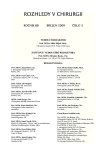Limitations of Liver Resections
Authors:
Ľ. Laca; J. Urdzik; Fani M. Dobrota D. *; H. Poláček **
Authors‘ workplace:
Klinika transplantačnej a cievnej chirurgie, Martin, Slovenská republika, prednosta: doc. MUDr. Ľ. Laca, Ph. D.
; Ústav klinickej biochémie, Martin, Slovenská republika, prednosta: prof. MUDr. D. Dobrota, Ph. D.
*; Rádiologická klinika, Martin, Slovenská republika, prednosta MUDr. H. Poláček, CSc.
**
Published in:
Rozhl. Chir., 2009, roč. 88, č. 3, s. 127-132.
Category:
Monothematic special - Original
Overview
Evaluation of the functional reserve before resectional performance and sufficient rest of liver parenchyma function is essential for the surgeon. From these factors, the decision based on operability, the maximum extent of liver parenchyma resection and the severity of post-operative course.
In the period from December 2003 to December 2008, at the Dept of Transplant and Vascular surgery, JLF UK Martin, have been performed 161 resections of the liver in 144 patients, of which 91 large resections performances in the liver (hemihepatektomies or greater performance). Six patients have undergone repeated resection (4.1%), in 11 patients was performed Radio Frequency Ablation due to relaps of the disease(6.1%), and 3 patients were performed two steps resection.
Of 91 major resection performance in the liver was 62 (68%) performed by anatomical boundaries of individual segments, in remaining 29 (32%) resections was reflected more to the localization of tumor itself as anatomical subdivision called combined anatomical and non-antomical resection. Radical resection R0 has been achieved in 76% of malignant tumors. In the post-operative course in 17% experienced complications, most often to the hematoma and biloma in plače of the resection area, pleural effusion and 8 patients had post-operative liver dysfunction. Of this group, 5 patients had made volumetric examinations, and in all was the volume of residual liver parenchyma < 30% of the total volume of functional liver. Mortality within 30 days of the performance was 1.1%. The survival of patients was affected mainly by extent of resection, histological type of tumor, radicality of resection and necessity of the complex surgical procedures.
Based on our evaluation of the results of a group of patients was arranged scheme measures for planning resectional procedures of the liver in our department. These include the adjustment of laboratory parameters, management of jaundice, preference of anatomical resections and volumetric examinations in patients with an estimated loss of more than 60–70% functional parenchyma of liver.
Key words:
functional reserve of the liver – liver resection – post-operative liver dysfunction
Sources
1. Jarnagin, W. R., Gonen, M., Fong, Y., et al. Improvement in perioperative outcome after hepatic resection: analysis of 1,803 consecutive cases over the pást decade. Ann. Surg., 2002; 236 : 397–406.
2. Bennett, J. J., Bumgart, L. H. Assessment of hepatic reserve prior to hepatic resection. J. Hepatobiliary Pancreat. Surg., 2005; 12 : 10–15.
3. Laca, L., Olejnik, J. Diagnostika a invazívna liečba chorôb pečene. Aktuálne odborné texty. Bratislava, Ebner, 2003.
4. Gazzaniga, G. M., Cappato, S., Belli, F. E., et al. Assessment of hepatic reserve for the indication of hepatic resection: how I do it. J. Hepatobiliary Pancreat. Surg., 2005; 12 : 27–30.
5. Třeška, V., Skalický, T., Liška, V., et al. Repeated procedures for colorectal liver metastases. Hepatogastroenterology, 2007; 54 : 1775–1778.
6. Lee, S. G., Hwang, S. How I do it: assessment of hepatic functional reserve for indication of hepatic resection. J. Hepatobiliary Pancreat. Surg., 2005; 12 : 38–43.
7. Figueras, J., Torras, J., Valls, C., et al. Surgical resection of colorectal liver metastases in patients with expanded indications: a single-center experience with 501 patients. Dis. Colon Rectum, 2007; 50 : 478–488.
8. Hewes, J. C, Dighe, S., Morris, R. W., et al. Preoperative chemotherapy and the outcome of liver resection for colorectal metastases. World J. Surg., 2007; 31 : 353–666.
9. Mullen, J. T., Ribero, D., Reddy, S. K., et al. Hepatic insufficiency and mortality in 1,059 noncirrhotic patients undergoing major hepatectomy. J. Am. Coll. Surg., 2007; 204 : 854–864.
10. Ferrero, A., Vigano, L., Polastri, R., et al. Postoperative Liver Dysfunction and Future Remnant Liver: Where Is the Limit? : Results of a Prospective Study. World J. Surg., 2007; 31 : 1643–1651.
11. Urdzik, J. Hodnotenie funkčnej rezervy pečene pred resekčnými výkonmi. Dizertačná práca, Martin, 2008.
12. Třeška, V.: Liver resection technique – current advances. Rozhl. Chir., 2007; 86 : 333–335.
13. Laca, L., Olejnik, J., Vician, M., et al. The effects of occlusive techniques on the short-term prognosis after liver resections. Hepatogastroenterology, 2006; 53 : 576–579.
14. van den Broek, M. A. J., Daming, S. W., Dejong, C. H., et al. Liver failure after poartial hepatic resection: Definition, patho - physiology, risk factors and treatment. Liver Int., 2008; 26 : 767–780.
15. Dindo, D., DeMartines, N., Clavien, P. Classification of surgical complications. Ann. Surg., 2004; 240 : 205–213.
Labels
Surgery Orthopaedics Trauma surgeryArticle was published in
Perspectives in Surgery

2009 Issue 3
Most read in this issue
- Position Variability of the Vermiform Appendix and Effect on Diagnosis of Appendicitis in Children
- Limitations of Liver Resections
- Bouveret‘s Syndrome – A Rare Case of Proximal Ileus of Biliary Etiology
- Giant Solitary Fibrous Tumor of the Pleura – Case Report
